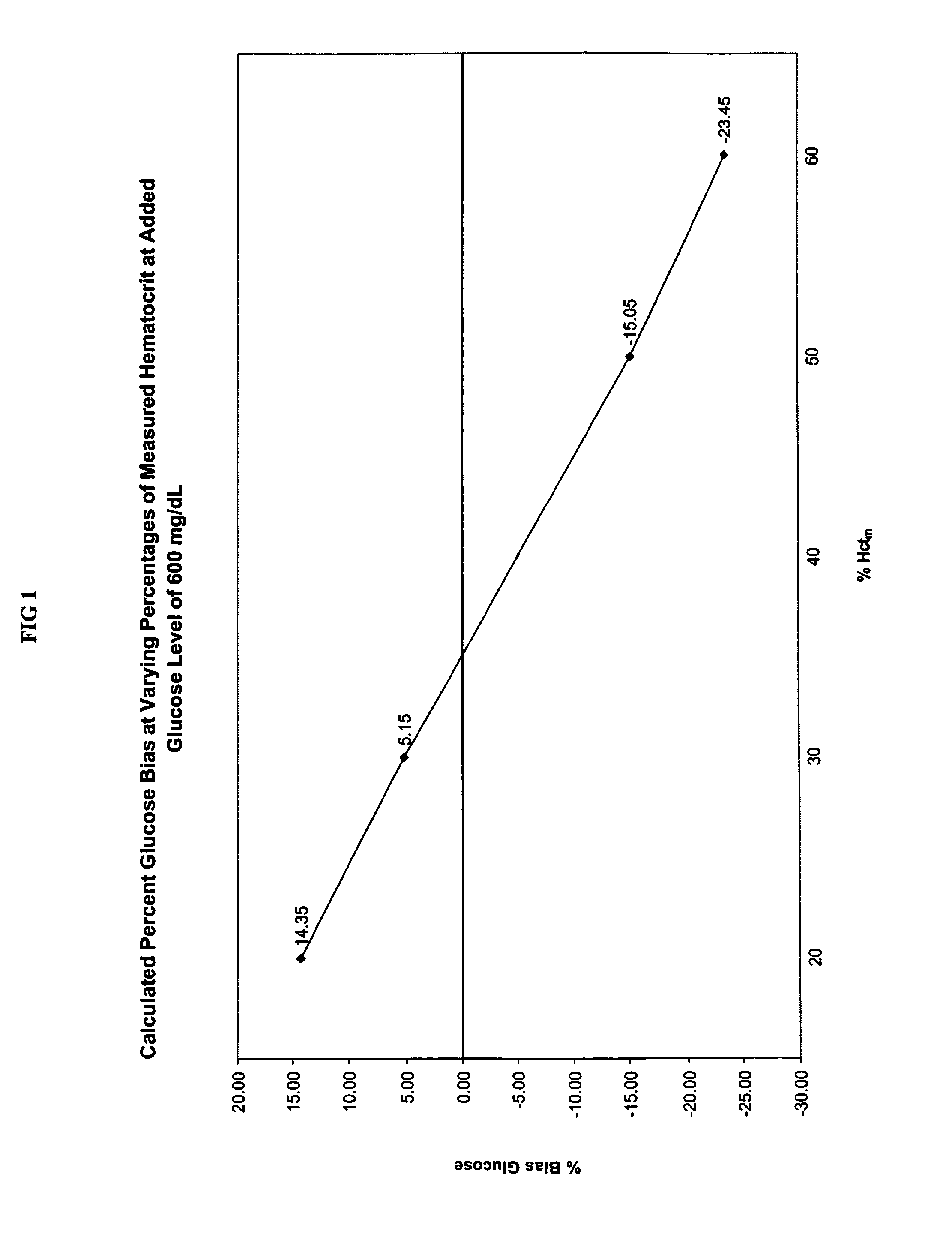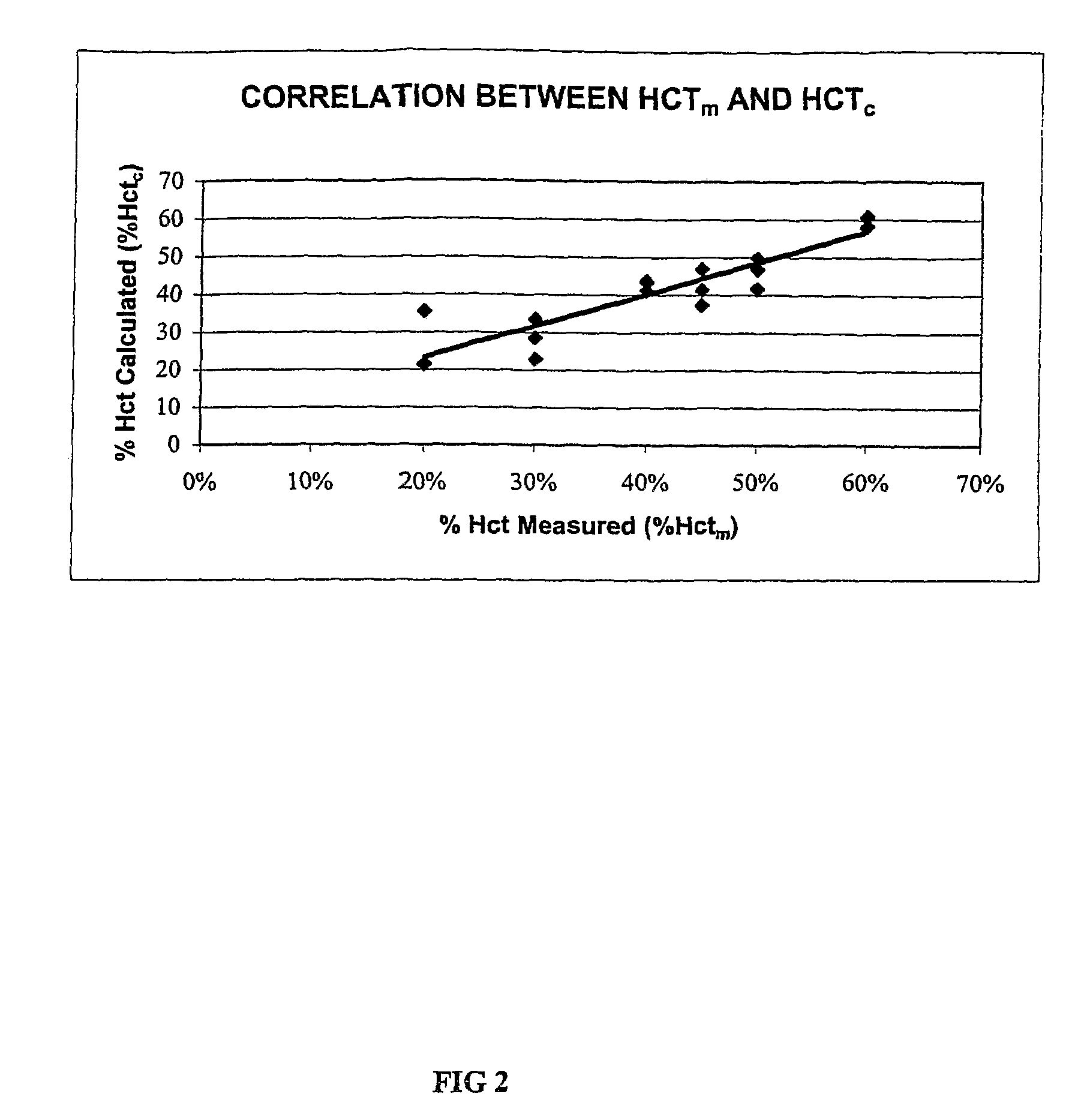Methods for performing hematocrit adjustment in glucose assays and devices for same
a technology of glucose assay and hematocrit, which is applied in the direction of biomass after-treatment, instruments, and investigating phase/state change, etc., can solve the problems of poor glucose monitoring product performance, less accurate glucose reading, and interference in the glucose value of a whole blood sample, so as to measure the resistance of the blood sampl
- Summary
- Abstract
- Description
- Claims
- Application Information
AI Technical Summary
Problems solved by technology
Method used
Image
Examples
example 1
Hematocrit Effect on Glucose Measurement
[0049]This example illustrates the hematocrit effect (i.e., the bias reading derived from hematocrit content) that is observed in glucose biosensor reagents. To illustrate the variation in the measured glucose level that is obtained with whole blood samples having different hematocrit content, four aliquots of whole blood (Samples 1-4) were obtained and pooled together.
[0050]The hematocrit content of Samples 1-4 was adjusted to 20 Vol. %, 30 Vol. %, 50 Vol. %, and 60 Vol. % Hct, respectively, using the hematocrit adjustment protocol described below. The volume of plasma to be added to each of the four aliquots of whole blood (i.e., Samples 1-4) to achieve the target hematocrit contents (i.e., 20 Vol. %, 30 Vol. %, 50 Vol. %, and 60 Vol. % Hct) was calculated using the relationship set forth in Equation 5:
[0051]P=(HctoHctt)-1×V(Eq.5)
where
[0052]P=Volume of plasma to be added or subtracted from the volume of the whole blood sample (V)
[0053]V=Vol...
example 2
Derivation of Hematocrit Adjustment Factor for Glucose
[0073]This example explains the derivation process for one embodiment of Equation 3 described above. Six whole blood samples were obtained and were divided into Samples 5-10. Using the hematocrit adjustment protocol set forth in Example I above, the hematocrit contents of Samples 5-10 were adjusted to 20 Vol. %, 30 Vol. %, 40 Vol. %, 45 Vol. %, 50 Vol. %, and 60 Vol. % Hct respectively (i.e., the measured percent hematocrit, % Hctm, levels). The measured percent hematocrit, % Hctm, levels (i.e., the 20 Vol. %, 30 Vol. %, 40 Vol. %, 45 Vol. %, 50 Vol. %, and 60 Vol. % Hctm levels) were obtained by measurement on a Compur M1100 micro-centrifuge.
[0074]Using three lots of DEX® biosensor reagents (Lots C, D, and E) and a BAS 100B Analyzer electrochemical device, the resistance of the blood sample (Rcell) and the resistance of plasma (Rplasma) of Samples 5-10 were measured. The test potential of the working electrode was 400 mV, and th...
example 3
Determination of Adjustment Factor
[0084]This example explains the process involved in determining the need for hematocrit correction, in determining the hematocrit correction factor, and in performing the hematocrit correction. The process begins by having a home glucose monitor user apply blood to an electrochemical sensor. The home glucose monitor will electrochemically determine the resistance of the blood sample, Rcell, using a biosensor reagent. The resistance of plasma, Rplasma, for the particular sensor lot will be electrochemically determined using a biosensor reagent by the manufacturer prior to shipment of the home glucose monitor. The value of Rplasma will be stored in the calibration chip or label or will be provided to the user for programming into the home glucose monitor.
[0085]Using the values of Rcell and Rplasma, the calculated resistance of red blood cells, RRBC, is mathematically determined within the home glucose monitor. Once the RRBC has been determined, the pe...
PUM
| Property | Measurement | Unit |
|---|---|---|
| volume | aaaaa | aaaaa |
| concentrations | aaaaa | aaaaa |
| concentrations | aaaaa | aaaaa |
Abstract
Description
Claims
Application Information
 Login to View More
Login to View More - R&D
- Intellectual Property
- Life Sciences
- Materials
- Tech Scout
- Unparalleled Data Quality
- Higher Quality Content
- 60% Fewer Hallucinations
Browse by: Latest US Patents, China's latest patents, Technical Efficacy Thesaurus, Application Domain, Technology Topic, Popular Technical Reports.
© 2025 PatSnap. All rights reserved.Legal|Privacy policy|Modern Slavery Act Transparency Statement|Sitemap|About US| Contact US: help@patsnap.com



